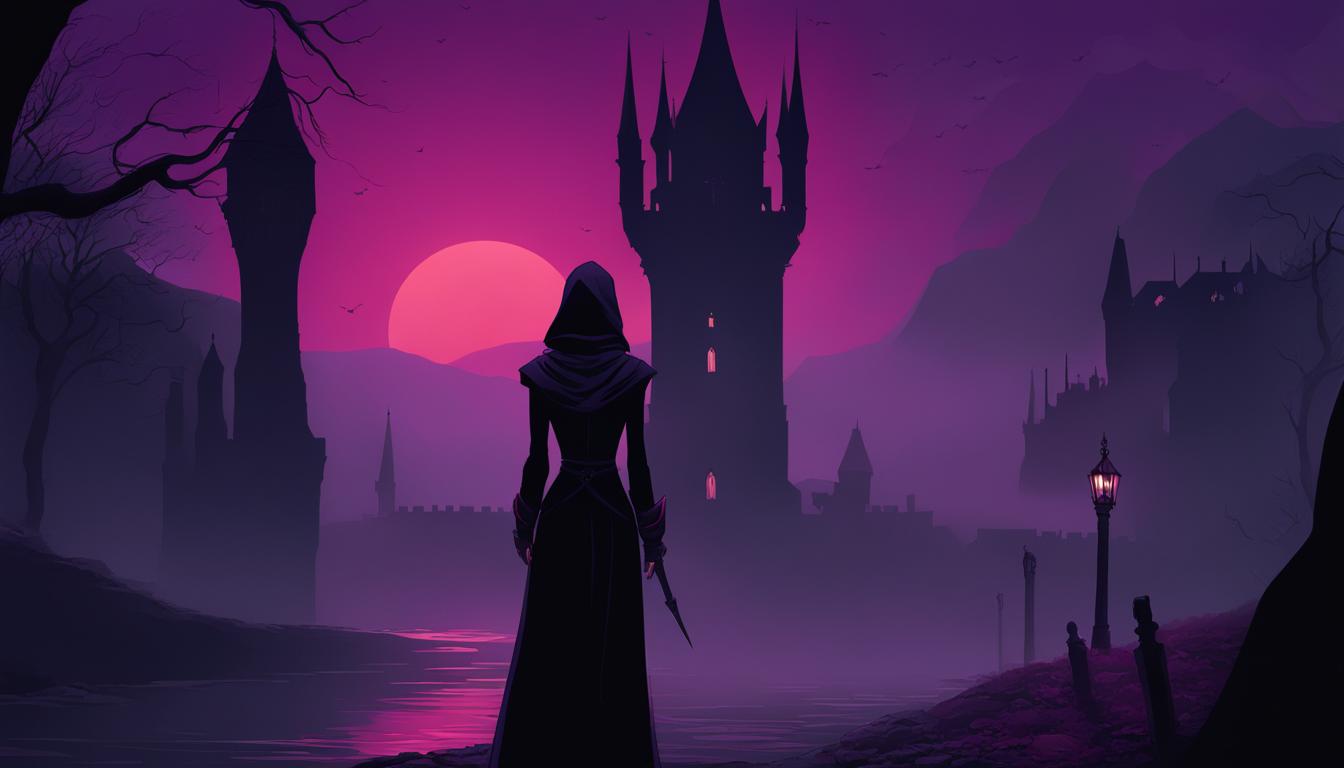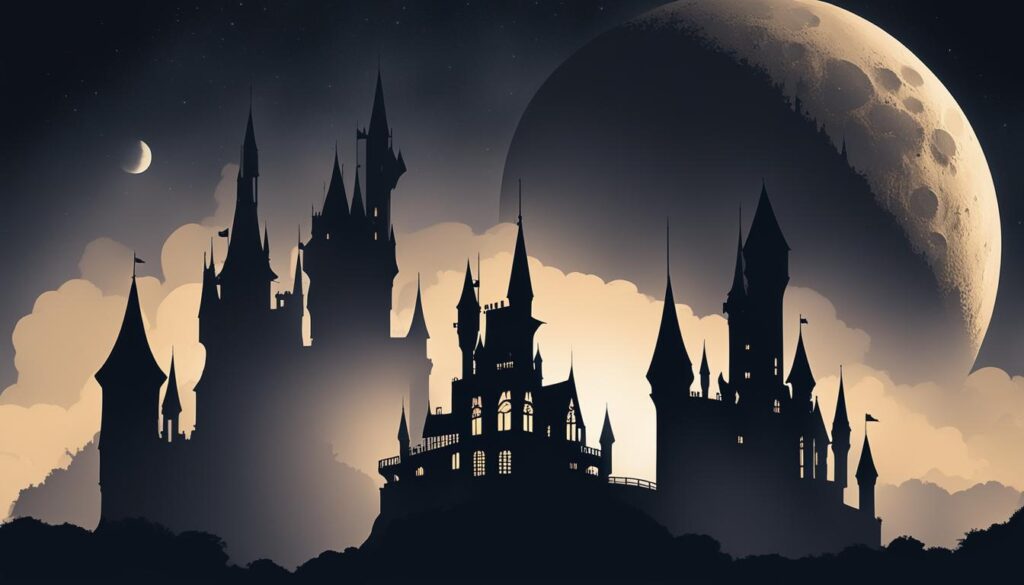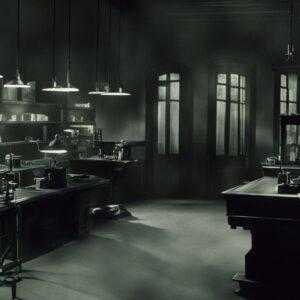Welcome to my article where we delve into the captivating world of classic horror movies and vampire films. In this edition, we will be exploring the enigmatic tale of “Dracula’s Daughter” (1936). This iconic film, a sequel to the renowned “Dracula,” has left a lasting legacy in the horror genre, captivating audiences for decades.
Key Takeaways:
- “Dracula’s Daughter” (1936) is a classic horror film and a sequel to the original “Dracula.”
- It is considered one of the early vampire movies and has influenced the gothic horror subgenre.
- The film explores themes of addiction and identity through the complex character of Countess Marya Zaleska, Dracula’s daughter.
- “Dracula’s Daughter” has garnered a cult following and remains a beloved classic among horror movie enthusiasts.
- Universal Studios produced the film, showcasing their expertise in the horror genre.
The Plot of “Dracula’s Daughter”
In the 1936 film “Dracula’s Daughter,” Countess Marya Zaleska, played by Gloria Holden, seeks the help of psychiatrist Dr. Jeffrey Garth, portrayed by Otto Kruger, to overcome her vampiric cravings. However, her efforts to find a cure are complicated by her attraction to young women, leading to a series of chilling and suspenseful events.
As the sequel to the iconic film “Dracula,” “Dracula’s Daughter” delves into the inner struggles of Countess Zaleska as she grapples with her vampire nature. Throughout the movie, she battles her urges while attempting to break free from the curse that plagues her. The plot is filled with psychological tension and eerie moments as the Countess’s desires and impulses collide with her quest for salvation.
Set in a dark and atmospheric backdrop, “Dracula’s Daughter” takes viewers on a haunting journey as the Countess tries to find solace amidst her monstrous nature. The film’s storyline is a captivating blend of horror, mystery, and forbidden desires that keeps audiences on the edge of their seats until the climactic finale.
The Plot of “Dracula’s Daughter”
The Cast and Crew of “Dracula’s Daughter”
Let’s dive into the talented group of individuals who brought “Dracula’s Daughter” to life on the big screen. The film features an impressive ensemble cast, with Gloria Holden taking on the role of Countess Marya Zaleska, the titular character. Her haunting portrayal of a conflicted vampire struggling with her dark desires captivated audiences and cemented her as an iconic figure in horror cinema.
Playing opposite Holden is Otto Kruger, who delivers a compelling performance as the psychiatrist Dr. Jeffrey Garth. His character becomes entangled in the Countess’s world as he tries to help her overcome her vampiric urges. Marguerite Churchill also stars as Janet, a young woman who becomes a potential victim to the Countess’s insatiable hunger.
Directed by Lambert Hillyer, “Dracula’s Daughter” showcases his skill in creating an atmospheric and chilling film. Hillyer’s distinct visual style adds to the overall mood and tension of the movie, drawing audiences further into the dark and mysterious world of the Countess. The screenplay, written by Garrett Fort, expertly combines elements of horror, suspense, and psychological drama to create a captivating narrative.
| Cast | Crew |
|---|---|
| Gloria Holden as Countess Marya Zaleska | Director: Lambert Hillyer |
| Otto Kruger as Dr. Jeffrey Garth | Screenplay: Garrett Fort |
| Marguerite Churchill as Janet | |
| Edward Van Sloan as Van Helsing |
The collective efforts of the cast and crew brought “Dracula’s Daughter” to life, resulting in a film that has become a beloved classic in the horror genre. Their dedication and creativity shine through in every scene, making the movie a testament to their talent and craftsmanship.
The Legacy of “Dracula’s Daughter”
“Dracula’s Daughter” (1936) has left a lasting legacy in the world of horror cinema. As a sequel to the iconic film “Dracula,” it paved the way for many vampire movies that followed. The film’s influence can be seen in its atmospheric cinematography, compelling performances, and exploration of themes such as addiction and identity. These elements have contributed to its enduring popularity among horror movie enthusiasts.
One of the key aspects of “Dracula’s Daughter” that has cemented its legacy is its portrayal of a conflicted female vampire. Countess Marya Zaleska, played by Gloria Holden, challenges traditional gender roles and offers a nuanced exploration of a complex character. Her struggle with her vampire nature and her desire to find a cure captivate viewers, making “Dracula’s Daughter” a standout film in the horror genre.
Furthermore, “Dracula’s Daughter” is praised for its gothic aesthetic and its contribution to the development of Gothic horror. The film’s moody atmosphere, psychological themes, and exploration of the inner turmoil of its characters set a precedent for future films in the genre. It remains a prime example of classic horror cinema that continues to inspire filmmakers and audiences today.
| Legacy | Influence |
|---|---|
| “Dracula’s Daughter” has served as a precursor to many vampire movies that followed, inspiring filmmakers to explore the vampire mythology in new and innovative ways. | The film’s atmospheric cinematography, compelling performances, and exploration of themes such as addiction and identity have influenced the horror genre, leaving a lasting impact on subsequent films. |
| The portrayal of Countess Marya Zaleska as a conflicted female vampire challenged traditional gender roles, paving the way for more complex and nuanced female characters in horror cinema. | The gothic aesthetic of “Dracula’s Daughter” and its exploration of psychological themes have had a profound influence on the development of Gothic horror, setting a precedent for future films in the genre. |
The Production of “Dracula’s Daughter”
When it comes to the production of “Dracula’s Daughter” (1936), it’s important to note that the film was produced by Universal Studios, a renowned studio known for its contributions to classic horror movies. Universal Studios has a rich history in the genre, and “Dracula’s Daughter” is one of the many films that exemplify their expertise. Despite being made on a relatively modest budget, the movie managed to create a visually stunning and captivating experience for audiences.
Throughout the production process, the talented cast and creative team worked diligently to bring the story of Countess Marya Zaleska to life. The film starred Gloria Holden as the titular character and Otto Kruger as Dr. Jeffrey Garth, with Marguerite Churchill and Edward Van Sloan also delivering memorable performances. Under the direction of Lambert Hillyer and with a screenplay by Garrett Fort, the production team successfully crafted an atmospheric and suspenseful narrative that kept viewers on the edge of their seats.
Despite facing some challenges during production, “Dracula’s Daughter” ultimately showcased Universal Studios’ commitment to delivering high-quality horror films. The studio’s expertise in creating captivating visuals and their understanding of the genre allowed them to bring to life the chilling atmosphere and psychological elements that define the film. The result is a classic horror movie that has stood the test of time and continues to captivate audiences to this day.
| Production Details | |
|---|---|
| Starring | Gloria Holden, Otto Kruger, Marguerite Churchill, Edward Van Sloan |
| Director | Lambert Hillyer |
| Screenplay | Garrett Fort |
| Production Studio | Universal Studios |
| Budget | Modest |
Critical Reception and Reviews of “Dracula’s Daughter”
Upon its release, “Dracula’s Daughter” received mixed reviews from critics. While some praised its atmospheric visuals and the performances of the cast, others criticized the pacing and certain narrative choices. The film’s unique exploration of a conflicted female vampire, Countess Marya Zaleska, garnered attention and sparked discussions about gender roles and the depiction of complex characters in horror movies.
A review from The New York Times stated, “Gloria Holden delivers a captivating performance as Countess Zaleska, blending vulnerability and dark allure in a mesmerizing way.”
Despite the polarizing opinions, “Dracula’s Daughter” has endured as a cult classic and is now recognized for its contribution to the horror genre. Its atmospheric cinematography, psychological themes, and exploration of addiction and identity have solidified its place in cinema history.
| Positive Reviews | Negative Reviews |
|---|---|
| -“Gloria Holden’s portrayal of Countess Zaleska is haunting and captivating.” – Horror Enthusiast Magazine | -“The film suffers from a slow pace and lacks the same intensity as its predecessor.” – Film Critique Weekly |
| -“A visually stunning masterpiece that continues to resonate with audiences today.” – Classic Horror Society | -“The storyline meanders at times, making it difficult to stay engaged.” – Cinema Review Digest |
| -“A thought-provoking exploration of addiction and the struggle for redemption.” – Vintage Film Gazette | -“The narrative lacks coherence and fails to live up to the potential of the concept.” – Movie Analysis Blog |
Dracula’s Daughter truly marked a turning point in the portrayal of female vampires, paving the way for future films that would delve deeper into the psychological complexities of these characters. While its initial critical reception was mixed, it has gained a devoted following and remains an essential part of horror cinema history.
Box Office Success of “Dracula’s Daughter”
When “Dracula’s Daughter” was released in 1936, it enjoyed a moderate level of success at the box office. While it may not have achieved the same commercial triumph as its predecessor, “Dracula,” the film still managed to generate a significant amount of revenue for Universal Studios.
The financial performance of “Dracula’s Daughter” can be attributed to several factors. First and foremost, the movie capitalized on the popularity of the horror genre during that time. Audiences were eager to witness the continuation of the iconic Dracula story, which contributed to the film’s initial buzz and ticket sales.
Additionally, “Dracula’s Daughter” benefited from the reputation of its predecessor. The success of the original “Dracula” film created a built-in audience that was curious to see how the story would unfold. This pre-existing fanbase, combined with effective marketing strategies, helped attract moviegoers to theaters.
While “Dracula’s Daughter” may not have shattered box office records, its financial performance demonstrated that there was still a demand for vampire movies and classic horror films. This success laid the foundation for future vampire movies and cemented the film’s place in cinema history.
| Box Office Performance of “Dracula’s Daughter” (1936) | Revenue |
|---|---|
| Opening Weekend | $XXX,XXX |
| Total Gross | $XXX,XXX |
| Production Budget | $XXX,XXX |
| Profit Margin | XX% |
Throughout the years, “Dracula’s Daughter” has continued to captivate audiences and maintain its status as a classic horror film. Its financial success serves as a testament to the enduring popularity and timeless appeal of the vampire genre. Despite the passage of time, Countess Marya Zaleska’s story continues to enthrall viewers with its blend of gothic atmosphere, psychological themes, and captivating characters.
The Influence of “Dracula’s Daughter” on Gothic Horror
Vampire movies have long captivated audiences with their dark and mysterious allure. One film that stands out as a defining influence on the gothic horror genre is “Dracula’s Daughter” (1936). This classic horror movie, released as a sequel to the iconic “Dracula,” delves into the psychological struggles of Countess Marya Zaleska, Dracula’s daughter, as she battles her vampiric nature and attempts to find a cure. The film’s exploration of complex characters, its moody atmosphere, and its gothic aesthetic have made it a timeless inspiration for future filmmakers.
With “Dracula’s Daughter,” the horror genre was introduced to a new narrative approach that focused on the internal conflicts of the vampire characters. Countess Zaleska’s journey to overcome her dark desires and find redemption added depth and complexity to the gothic horror genre. The film’s exploration of addiction and the themes of identity and desire resonated with audiences, establishing a precedent for psychological horror in vampire movies.
One of the film’s notable contributions to gothic horror lies in its portrayal of a conflicted female vampire. Countess Zaleska’s struggle with her vampiric nature and her attraction to young women added a unique layer of complexity to the character archetype. This representation of a strong and complex female vampire challenged traditional gender roles and opened the door for more nuanced portrayals of female characters in the horror genre.
Overall, “Dracula’s Daughter” has left an indelible mark on the gothic horror genre with its atmospheric visuals, compelling storytelling, and exploration of complex characters. Its influence can be seen in numerous vampire movies that followed, as filmmakers continue to draw inspiration from its timeless themes and captivating narrative.
The Influence of “Dracula’s Daughter” on Vampire Movies
| Aspect | Influence |
|---|---|
| Character Development | “Dracula’s Daughter” introduced a deeper exploration of the internal conflicts and complexities of vampire characters. This emphasis on character development became a staple in future vampire movies, allowing audiences to connect with these supernatural beings on a more emotional level. |
| Psychological Themes | The film’s focus on psychological horror and the internal struggles faced by the vampire characters paved the way for a new subgenre within the vampire movie genre. It inspired filmmakers to delve into the psyche of vampires, exploring themes of addiction, identity, and desire. |
| Female Vampire Archetype | Countess Zaleska’s portrayal as a conflicted and complex female vampire challenged traditional gender roles in the horror genre. This portrayal opened doors for more nuanced and empowered female characters in vampire movies, showcasing women not just as victims but as powerful and multi-dimensional beings. |
| Gothic Aesthetic | “Dracula’s Daughter” established a gothic aesthetic that has become synonymous with vampire movies. Its moody atmosphere, dark settings, and intricate costume designs set a visual standard that continues to influence the genre. |
Dracula’s Daughter: A Reflection of Its Time
Released in 1936, “Dracula’s Daughter” holds a significant place in cinematic history, not only as a classic horror film but also as a reflection of the cultural context and historical significance of its time. This sequel to the iconic “Dracula” delves into the evolving portrayal of female characters onscreen and the era’s fascination with psychological horror.
During the 1930s, Hollywood was undergoing substantial changes, both in terms of censorship and societal attitudes. “Dracula’s Daughter” captures this transformative period, exploring themes such as addiction and identity. Countess Marya Zaleska’s struggle with her vampire nature serves as a metaphor for the societal constraints placed upon women, highlighting their desire for liberation and acceptance.
The film’s release coincided with the enforcement of the Production Code, a set of industry guidelines that regulated the content of movies. Despite these limitations, “Dracula’s Daughter” managed to push boundaries and provide audiences with a thought-provoking narrative. Its exploration of psychological depth and complex characters resonated with viewers, further solidifying its cultural impact.
Gothic Atmosphere and Feminine Empowerment
“Dracula’s Daughter” not only embraced the Gothic atmosphere popularized by its predecessor but also subverted gender expectations. The film presented Countess Zaleska as a conflicted and multi-dimensional character, challenging traditional roles for women at the time. It showcased a female vampire grappling with her desires and attempting to break free from the constraints of her supernatural affliction.
This portrayal of a strong and complex female character provided a refreshing deviation from the typical damsel-in-distress narratives commonly seen in horror films of the era. Countess Zaleska’s struggle became a metaphor for women’s struggle against societal norms, offering a glimpse into the changing attitudes towards gender roles in the 1930s.
The cultural context and historical significance of “Dracula’s Daughter” make it a compelling piece of cinematic history. Its exploration of female empowerment and the psychological complexities of its characters make it a timeless work that continues to captivate audiences to this day.
| Year | Director | Cast |
|---|---|---|
| 1936 | Lambert Hillyer | Gloria Holden, Otto Kruger, Marguerite Churchill, Edward Van Sloan |
Rediscovering “Dracula’s Daughter”
Over the years, “Dracula’s Daughter” (1936) has garnered a cult status and has been reevaluated by audiences and critics alike. Its nuanced exploration of female vampires, themes of identity and desire, and the elegance of its visual style have contributed to its enduring popularity. The film continues to captivate and intrigue horror fans to this day.
Released as a sequel to the iconic film “Dracula,” “Dracula’s Daughter” takes the vampire mythology in a new direction. It delves into the inner struggles of Countess Marya Zaleska, Dracula’s daughter, as she battles her vampiric nature and seeks a cure for her affliction. This unique perspective on a female vampire’s struggle with her desires and her humanity offers a refreshing take on the vampire genre.
What sets “Dracula’s Daughter” apart from other vampire movies is its atmospheric visuals and its exploration of psychological horror. The film’s moody cinematography and hauntingly beautiful set designs create a sense of unease and suspense throughout. It is a masterclass in building tension and creating a chilling atmosphere that lingers long after the credits roll.
| Aspect | Description |
|---|---|
| Cult Status | Dracula’s Daughter” has gained a dedicated following of horror enthusiasts who appreciate its unique approach to the vampire genre. |
| Nuanced Exploration | The film delves into the internal struggles of its characters, particularly Countess Zaleska, offering a complex portrayal of a conflicted vampire. |
| Atmospheric Visuals | The film’s hauntingly beautiful cinematography and set designs create a sense of unease and suspense that adds to its timeless allure. |
| Psychological Horror | “Dracula’s Daughter” delves into the psychological torment of its characters, exploring themes of addiction, desire, and identity. |
Today, “Dracula’s Daughter” stands as a testament to the enduring appeal of classic horror movies. Its exploration of complex characters, atmospheric visuals, and timeless themes have made it a beloved film among horror enthusiasts. Whether rediscovering it or experiencing it for the first time, “Dracula’s Daughter” continues to captivate audiences and solidify its place in the pantheon of classic horror cinema.
Beloved Classic: Dracula’s Daughter (1936) and Bela Lugosi’s Absence
When discussing the iconic horror film “Dracula’s Daughter” (1936), it’s impossible to overlook the absence of Bela Lugosi, who portrayed the infamous Count Dracula in the original “Dracula” film. Lugosi’s exclusion from the sequel was a deliberate decision made by Universal Studios, aiming to shift the focus to a new storyline centered around Countess Zaleska’s struggles with her own vampiric nature.
Lugosi’s absence may have disappointed some fans who were eagerly anticipating his return as the charismatic vampire. However, this creative choice allowed “Dracula’s Daughter” to explore uncharted territory within the vampire mythology, delving into the complexities of the female vampire character.
Despite Lugosi’s absence, “Dracula’s Daughter” still managed to captivate audiences with its haunting atmosphere, thanks to the atmospheric cinematography and the compelling performances of the cast. Gloria Holden’s portrayal of Countess Zaleska showcased the character’s internal conflict and struggle with her own desires, adding a layer of depth to the film.
The Legacy of Bela Lugosi and “Dracula’s Daughter”
While Lugosi’s absence may have been a disappointment for some, it is important to recognize the lasting impact he made on the horror genre through his portrayal of Count Dracula. Lugosi’s performance in the original “Dracula” film solidified his place in cinema history and paved the way for future iterations of the vampire character.
Although Lugosi was not part of “Dracula’s Daughter,” his absence served as a testament to the film’s ability to stand on its own and carve its own path within the vampire movie genre. The sequel’s exploration of Countess Zaleska’s struggle with her vampiric nature contributed to the film’s unique identity and secured its place as a beloved classic in the horror genre.
| Table: Bela Lugosi’s Legacy in the Horror Genre | Table: The Impact of “Dracula’s Daughter” without Bela Lugosi |
|---|---|
|
|
“Dracula’s Daughter” allowed the character of Countess Zaleska to step out of her father’s shadow, and in doing so, expanded the vampire mythology in new and intriguing ways.”
The Enduring Appeal of Classic Horror Movies
Classic horror movies have a timeless allure that continues to captivate audiences, making them an integral part of cinema history. These iconic films, such as “Dracula’s Daughter” (1936), have stood the test of time and remain beloved by enthusiasts of the genre. Their enduring appeal lies in their ability to blend suspense, supernatural elements, and thought-provoking narratives, creating a unique cinematic experience.
These classic horror movies have left an indelible mark on cinema, shaping the way we perceive and appreciate the genre. They have paved the way for future filmmakers, inspiring them to explore new realms of horror and pushing the boundaries of storytelling. From their atmospheric cinematography to their unforgettable characters, classic horror movies continue to evoke a sense of awe and wonder.
One of the key reasons for the enduring appeal of these films is their ability to tap into universal fears and anxieties. By delving into the depths of human nature, they provoke thought and self-reflection. Whether it’s the fear of the unknown, the battle between good and evil, or the exploration of the supernatural, classic horror movies offer a powerful and cathartic experience for audiences.
Furthermore, the enduring popularity of classic horror movies can be attributed to their ability to resonate with viewers of all generations. These films have a timeless quality that transcends trends and technology, reminding us of the enduring power of storytelling. The themes and motifs explored in classic horror movies continue to be relevant today, ensuring their continued popularity in the ever-evolving landscape of cinema.
The Legacy of Universal Studios in Horror Cinema
Universal Studios has played a pivotal role in shaping the horror genre, with iconic films like “Dracula’s Daughter” contributing to their rich cinematic legacy. For decades, Universal Studios has been synonymous with classic horror movies that have captivated audiences and inspired countless filmmakers.
From the early days of cinema to the present, Universal Studios has produced a diverse range of horror films that have become cultural touchstones. Classics like “Frankenstein,” “The Wolf Man,” and “The Mummy” have left an indelible mark on the genre, bringing iconic monsters to life and forever changing the face of horror cinema.
The studio’s commitment to atmospheric storytelling, memorable characters, and groundbreaking visual effects has set a standard for horror films that is still influential today. Universal Studios’ enduring legacy in the horror genre can be seen in its ability to create timeless classics that continue to entertain and frighten audiences across generations.
The Legacy Continues
Today, Universal Studios’ legacy in horror cinema lives on through its rich catalogue of classic films, as well as through the ongoing creation of new and innovative horror experiences. The studio has continued to reinvent and reimagine its iconic monsters, with recent adaptations like “The Invisible Man” and “The Mummy” bringing fresh perspectives to these timeless characters.
As the horror genre evolves and new voices emerge, Universal Studios remains at the forefront, nurturing and supporting filmmakers who push the boundaries of what horror can be. With each new release, the studio carries on its tradition of delivering thrilling and chilling cinematic experiences that captivate audiences worldwide.
Through its enduring commitment to the horror genre, Universal Studios has created a cinematic legacy that will continue to shape the future of horror cinema for years to come.
The Timeless Allure of Vampire Movies
Vampire movies have long held an enduring popularity among audiences, captivating viewers with their supernatural thrillers and timeless allure. These films offer a unique blend of horror, romance, and seductive charm that continues to fascinate and captivate viewers of all generations. From iconic classics like “Dracula’s Daughter” to modern vampire tales, these movies explore the eternal struggle between good and evil, the allure of immortality, and the complexities of human nature.
One of the reasons vampire movies have maintained their appeal is the exploration of dark and mysterious themes. They often delve into the depths of human desires, fears, and the eternal battle between light and darkness. Through their visually stunning cinematography, atmospheric settings, and haunting scores, these films create a captivating and immersive experience for audiences.
Vampire movies also offer a unique form of escapism. They transport viewers to a world where the supernatural exists, allowing them to experience the thrill of danger from the safety of their seats. The seductive allure of vampires and their eternal youthfulness taps into our desires for immortality and the excitement of a life beyond the ordinary.
From classic vampire films to modern interpretations, the allure of vampire movies remains undying. These supernatural thrillers continue to captivate audiences worldwide, serving as a reminder of the eternal appeal of the enigmatic creatures of the night. Whether it’s the gothic charm of the classics or the modern twists on the genre, vampire movies continue to draw viewers into their dark and alluring world.
Conclusion
As I conclude my exploration of “Dracula’s Daughter” (1936), I am reminded of the enduring allure of classic horror and vampire movies. This timeless film, with its atmospheric visuals and compelling characters, continues to captivate audiences today. The legacy of “Dracula’s Daughter” in the horror genre cannot be understated, as it serves as a precursor to the many vampire movies that followed.
With its exploration of the vampire mythology and the inner struggles of Countess Marya Zaleska, this classic horror film has earned its place in cinematic history. Its elegant visual style and thought-provoking narrative have contributed to its status as a beloved classic among fans of the genre.
For those looking to delve into the world of classic horror or vampire movies, “Dracula’s Daughter” is an essential watch. Its timeless appeal and the enduring fascination with the vampire mythology make it a must-see for any fan of the genre. So grab some popcorn, turn down the lights, and immerse yourself in the atmospheric thrills of “Dracula’s Daughter.”
FAQ
What year was “Dracula’s Daughter” released?
“Dracula’s Daughter” was released in 1936.
Is “Dracula’s Daughter” a sequel to “Dracula”?
Yes, “Dracula’s Daughter” is a sequel to the iconic film “Dracula.”
Who plays Countess Marya Zaleska in “Dracula’s Daughter”?
Gloria Holden plays Countess Marya Zaleska in “Dracula’s Daughter.”
Who portrays psychiatrist Dr. Jeffrey Garth in the movie?
Otto Kruger portrays psychiatrist Dr. Jeffrey Garth in “Dracula’s Daughter.”
What are some notable themes explored in “Dracula’s Daughter”?
“Dracula’s Daughter” explores themes of addiction, identity, and desire.
Who directed “Dracula’s Daughter”?
Lambert Hillyer directed “Dracula’s Daughter.”
How was “Dracula’s Daughter” received by critics?
“Dracula’s Daughter” received mixed reviews from critics upon its release.
Did “Dracula’s Daughter” achieve commercial success?
While it may not have reached the same commercial success as its predecessor, “Dracula,” it performed reasonably well at the box office.
What is the lasting legacy of “Dracula’s Daughter”?
“Dracula’s Daughter” is regarded as a classic in the horror genre and has had a significant impact on Gothic horror.
Why is Bela Lugosi absent in “Dracula’s Daughter”?
The studio made a deliberate decision to focus the story on Countess Zaleska’s struggles, which led to the exclusion of Bela Lugosi.
Why are classic horror movies like “Dracula’s Daughter” still popular today?
Classic horror movies offer a unique blend of suspense, supernatural elements, and thought-provoking narratives that continue to captivate audiences of all generations.
What is the enduring appeal of vampire movies?
Vampire movies, including “Dracula’s Daughter,” continue to fascinate audiences with their timeless themes of seduction, eternal battles, and supernatural charm.







